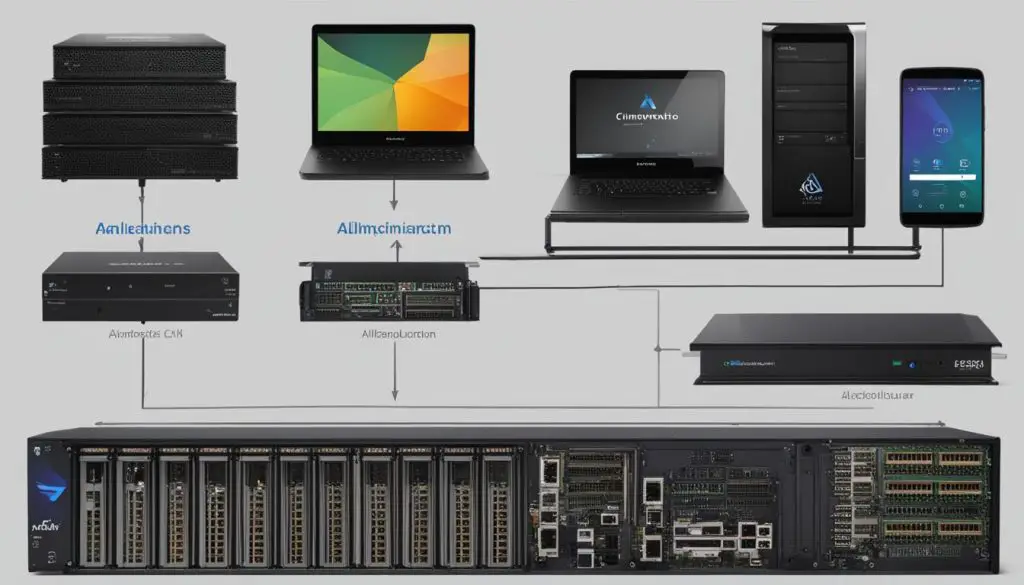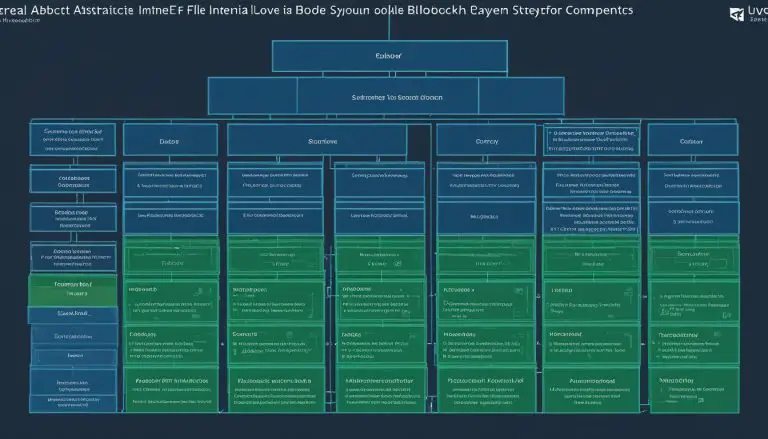Rocky Linux vs. AlmaLinux: A Comprehensive Comparison Review
Welcome to my comprehensive comparison review of Rocky Linux and AlmaLinux, two open-source Linux distributions that have emerged as replacements for CentOS. In this article, I will delve into the differences in features, compatibility, community support, and more, to help you make an informed decision when choosing between these two operating systems.
Key Takeaways:
- Rocky Linux and AlmaLinux are open-source Linux distributions that aim to replace CentOS.
- Both distributions offer compatibility with Red Hat Enterprise Linux (RHEL) and have a stable and bug-for-bug compatible operating system.
- Rocky Linux has a longer history and is led by the founder of CentOS, Gregory Kurtzer, while AlmaLinux is a downstream RHEL fork created by CloudLinux.
- Both distributions provide regular updates, with Rocky Linux recently improving its release lag.
- The teams behind both distributions have experience in rebuilding RHEL, ensuring a seamless transition for users.
- Both Rocky Linux and AlmaLinux deliver high performance, stability, and compatibility for running enterprise applications.
- Both distributions have community support, with growing certifications for enterprise apps on both platforms.
- AlmaLinux uses the dnf package manager by default, while Rocky Linux offers both rpm and dnf package managers.
- AlmaLinux includes the CIS Benchmark for enhanced system security, while Rocky Linux incorporates SELinux.
- The choice between Rocky Linux and AlmaLinux ultimately depends on individual preferences and specific requirements.
Introduction to Rocky Linux and AlmaLinux
Rocky Linux and AlmaLinux are open-source Linux distributions that have gained significant attention as replacements for CentOS. These distributions were developed to fill the void left by Red Hat’s decision to discontinue CentOS, which had long been a popular choice among enterprise users. Despite their common goal of providing a CentOS replacement, Rocky Linux and AlmaLinux have distinct origins and characteristics.
Rocky Linux, founded by Gregory Kurtzer, the original creator of CentOS, is based on the source code of Red Hat Enterprise Linux (RHEL). Its aim is to provide a stable and bug-for-bug compatible operating system that caters to enterprise needs. On the other hand, AlmaLinux is a downstream Red Hat Enterprise Linux fork developed by CloudLinux. Both distributions prioritize compatibility and stability, making them suitable alternatives for organizations seeking CentOS alternatives.
As open-source Linux distributions, Rocky Linux and AlmaLinux offer users the flexibility and freedom to modify and customize their systems according to their specific requirements. These distributions are designed to be RHEL-compatible, ensuring that enterprise applications designed for RHEL can be seamlessly migrated to either Rocky Linux or AlmaLinux.
While Rocky Linux and AlmaLinux share similarities in their mission and target audience, they also have distinct features and characteristics that set them apart. The following table provides a brief comparison of key aspects of these distributions:
| Aspect | Rocky Linux | AlmaLinux |
|---|---|---|
| Origin | Founded by Gregory Kurtzer, the original creator of CentOS | Developed by CloudLinux |
| Based on | Source code of Red Hat Enterprise Linux (RHEL) | Red Hat Enterprise Linux (RHEL) |
| Compatibility | RHEL-compatible, aimed at seamless migration of enterprise applications | RHEL-compatible, aimed at seamless migration of enterprise applications |
| Community Support | Active community involvement, leveraging expertise from CentOS community | Active community involvement, leveraging expertise from CloudLinux and CentOS communities |
While these are just some of the factors to consider when choosing between Rocky Linux and AlmaLinux, it is important to evaluate the specific needs and preferences of your organization before making a decision. Both distributions offer viable alternatives to CentOS and provide robust, enterprise-grade operating systems that can fulfill the requirements of a wide range of businesses.
Supported Architecture
Both Rocky Linux and AlmaLinux are versatile operating systems that support a wide range of architectures, catering to the diverse needs of users. The following table provides a comprehensive overview of the supported architectures for both distributions:
| Architecture | Rocky Linux | AlmaLinux |
|---|---|---|
| x86_64 | ✅ | ✅ |
| aarch64 | ✅ | ✅ |
| ppc64le | ✅ | ❌ |
| s390x | ✅ | ✅ |
Rocky Linux offers support for all four architectures, including x86_64, aarch64, ppc64le, and s390x. This makes it a suitable choice for users with diverse hardware requirements. On the other hand, AlmaLinux does not currently provide support for ppc64le, but it supports the other three architectures.
Whether you’re running on traditional x86_64 hardware, ARM-based systems, or IBM’s Power Systems, both Rocky Linux and AlmaLinux have you covered, ensuring compatibility and optimal performance across a wide range of platforms.
It’s worth noting that the availability of different architectures ensures that organizations can choose the most appropriate hardware for their specific needs, whether it’s high-performance servers or energy-efficient systems.

Updates and Release Cycle
One of the key factors to consider when choosing an operating system is the frequency and timeliness of updates. Both Rocky Linux and AlmaLinux have a regular release and update cycle, ensuring that users have access to the latest security patches and feature enhancements. However, it’s important to note that there may be slight differences in the release lag between the two distributions.
Initially, Rocky Linux had a longer delay in incorporating updates compared to AlmaLinux. This was primarily due to the project’s focus on ensuring the utmost quality and stability of the operating system. However, with the release of Rocky Linux version 9.0, the distribution introduced a new build system that aims to decrease the release lag and provide timely updates to users. This improvement demonstrates the project’s commitment to delivering a reliable and up-to-date operating system.
On the other hand, AlmaLinux also strives to expedite the release of updates and minimize the lag between Red Hat publishing package updates and their incorporation into the distribution. The project recognizes the importance of keeping the operating system secure and compatible with the latest software packages. As a result, AlmaLinux users can expect timely updates that address security vulnerabilities and bring new features.
Overall, both Rocky Linux and AlmaLinux are dedicated to maintaining an active and consistent release cycle to meet the needs of their users. While there may have been differences in the past, the recent advancements made by Rocky Linux’s new build system and AlmaLinux’s commitment to timely updates ensure that both distributions provide a reliable and secure operating environment.
Comparison Table: Updates and Release Cycle
| Operating System | Release Cycle | Update Lag |
|---|---|---|
| Rocky Linux | Regular | Decreased with version 9.0 |
| AlmaLinux | Regular | Minimal |
RHEL Rebuild Experience
Both Rocky Linux and AlmaLinux have extensive experience in rebuilding Red Hat Enterprise Linux (RHEL) into their respective distributions. The teams behind these operating systems have a deep understanding of the RHEL codebase and the process of creating a bug-for-bug compatible system. This experience ensures that both Rocky Linux and AlmaLinux are reliable and stable alternatives to CentOS, providing users with a seamless transition from the discontinued operating system.
The Rocky Linux team, led by Gregory Kurtzer, the founder of CentOS, brings invaluable expertise to the table. Kurtzer’s vision for Rocky Linux is to provide a community-driven, enterprise-grade Linux distribution that upholds the principles of open source. With their extensive experience in CentOS development and knowledge of the RHEL codebase, the Rocky Linux team is well-equipped to deliver a high-quality and user-friendly operating system.
The AlmaLinux team also possesses significant expertise in RHEL rebuilding. With their background in working on CloudLinux and CentOS, they have deep knowledge of the RHEL codebase and understand the intricacies of creating a bug-for-bug compatible distribution. The AlmaLinux team’s experience ensures that their distribution is a reliable and secure replacement for CentOS, providing users with a stable and compatible operating system for their enterprise needs.
Differences in Rebuild Approach
While both Rocky Linux and AlmaLinux have expertise in RHEL rebuilding, there are subtle differences in their approaches. Rocky Linux aims to provide a rebuilt RHEL clone that follows the same release cycle as its upstream source. This approach ensures that Rocky Linux remains in sync with RHEL, providing users with the latest bug fixes and security updates as soon as they are released by Red Hat.
On the other hand, AlmaLinux focuses on creating a stable and secure downstream fork of RHEL. Their goal is to provide a reliable and long-term support solution for CentOS users. AlmaLinux incorporates security updates and bug fixes from RHEL while maintaining compatibility with CentOS. This approach allows AlmaLinux to deliver a stable and secure operating system without deviating too far from the CentOS user experience.
Both Rocky Linux and AlmaLinux offer a seamless transition from CentOS, thanks to their RHEL rebuild experience and expertise. Whether you choose Rocky Linux or AlmaLinux, you can trust that you are getting a reliable and stable alternative to CentOS, backed by a dedicated community and experienced teams of developers.
| Rocky Linux | AlmaLinux | |
|---|---|---|
| Rebuild Approach | RHEL clone with same release cycle | Downstream fork with long-term support |
| Development Team | Led by Gregory Kurtzer, founder of CentOS | Experienced developers from CloudLinux and CentOS |
| Compatibility | Bug-for-bug compatible with RHEL | Compatible with CentOS, incorporates updates from RHEL |
| Community Support | Active community involvement | Community-driven development |
Performance
When it comes to performance, both Rocky Linux and AlmaLinux deliver outstanding results. These distributions are built to be 1:1 bug-for-bug compatible with RHEL, ensuring stability and compatibility with enterprise applications. Whether you choose Rocky Linux or AlmaLinux, you can expect reliable and efficient performance for your business needs.
While both distributions offer similar performance levels, there might be slight differences due to the use of custom software and optimizations. However, these differences are minimal and do not significantly impact the overall performance of the operating systems.
Whether your focus is on stability, compatibility, or overall performance, both Rocky Linux and AlmaLinux have proven themselves as reliable choices for organizations seeking CentOS replacements. The robust performance of these distributions makes them well-suited for running enterprise applications without any compromises.
Performance Comparison Table
| Performance Metrics | Rocky Linux | AlmaLinux |
|---|---|---|
| Stability | High | High |
| Compatibility | Full RHEL compatibility | Full RHEL compatibility |
| Custom Software | Minimal impact on performance | Minimal impact on performance |
| Optimizations | Custom optimizations for efficiency | Custom optimizations for efficiency |
The table above provides a comparison of performance metrics between Rocky Linux and AlmaLinux. Both distributions excel in stability and compatibility, delivering a seamless experience for enterprise users. The impact of custom software and optimizations is minimal, ensuring efficient performance for business-critical applications.
Support and Community
Support and community engagement are crucial factors to consider when choosing a Linux distribution for enterprise use. Both Rocky Linux and AlmaLinux benefit from active and vibrant communities that provide support and assistance to users.
Rocky Linux has a dedicated community that actively contributes to the development and improvement of the distribution. The community offers support through forums, mailing lists, and documentation resources. Users can find answers to their questions, troubleshoot issues, and collaborate with other members of the community.
AlmaLinux also has a strong and growing community that actively participates in the distribution’s development and support. The community provides assistance through forums, chat platforms, and regular updates on the progress of the distribution. Users have access to a network of experienced individuals who can help them resolve issues and optimize their AlmaLinux experience.
When it comes to enterprise application compatibility, both Rocky Linux and AlmaLinux have been gaining traction and attracting certifications from software vendors. As more organizations migrate to these CentOS replacements, the community support and expertise surrounding these distributions continue to grow, ensuring a reliable and well-supported environment for running enterprise applications.
Community Support Features
| Feature | Rocky Linux | AlmaLinux |
|---|---|---|
| Forums | Active community forums for support and discussion | Engaging forums with participation from community members |
| Documentation | Comprehensive documentation resources for troubleshooting and guidance | Extensive documentation for assistance and best practices |
| Chat Platforms | Dedicated chat channels for real-time support and collaboration | Chat platforms for immediate assistance and community interaction |
| Certifications | Increasing number of certifications from software vendors for enterprise app compatibility | Attracting certifications and support from software vendors for enterprise use |
Both Rocky Linux and AlmaLinux offer robust community support and engagement, making them reliable choices for organizations seeking CentOS replacements. The active communities surrounding these distributions ensure that users have access to resources, assistance, and expertise to successfully deploy and maintain their enterprise applications.
Package Managers and Security
When it comes to package managers, AlmaLinux relies solely on the dnf package manager as its default choice. On the other hand, Rocky Linux provides users with the option to choose between rpm and dnf package managers. This flexibility allows users to select the package manager that best suits their needs and preferences.
In terms of security features, AlmaLinux stands out with its inclusion of the CIS Benchmark. This feature enables users to configure system security settings and obtain comprehensive reports on potential security vulnerabilities. It provides organizations with valuable insights into their system’s security posture and helps them proactively address any identified issues.
AlmaLinux’s integration of the CIS Benchmark provides organizations with a robust security framework, allowing them to enhance their system security and protect critical assets.
Rocky Linux, on the other hand, incorporates the Security Enhanced Linux (SELinux) system to bolster security measures. SELinux provides mandatory access control policies, adding an additional layer of protection against unauthorized access and potential exploits.
Both AlmaLinux and Rocky Linux prioritize security and offer features that can help organizations strengthen their system defenses. Whether it’s the comprehensive reports and configurability provided by the CIS Benchmark in AlmaLinux or the additional security layer offered by SELinux in Rocky Linux, users can choose the distribution that aligns with their specific security requirements.
Conclusion
In conclusion, after a comprehensive comparison of Rocky Linux and AlmaLinux, both distributions prove to be strong contenders as replacements for CentOS. They offer stability, compatibility with RHEL, and active community support.
Choosing between Rocky Linux and AlmaLinux comes down to individual preferences and specific requirements. Organizations may consider factors such as community support, funding, and security features offered.
While AlmaLinux utilizes the dnf package manager by default and includes the CIS Benchmark for enhanced security, Rocky Linux offers the flexibility of both rpm and dnf package managers and incorporates the Security Enhanced Linux (SELinux) system.
Ultimately, the decision between Rocky Linux and AlmaLinux should be based on the unique needs and priorities of each organization. Both distributions provide reliable alternatives to CentOS and can meet the demands of enterprise-grade applications.
FAQ
What are Rocky Linux and AlmaLinux?
Rocky Linux and AlmaLinux are open-source Linux distributions created as replacements for CentOS after it was discontinued by Red Hat.
What is the supported architecture for Rocky Linux and AlmaLinux?
Both distributions support x86_64, aarch64, ppc64le, and s390x architectures. AlmaLinux added support for s390x with its latest version, while Rocky Linux added support for aarch64, ppc64le, and s390x with version 9.0.
How frequently are updates released for Rocky Linux and AlmaLinux?
Both distributions have a regular release and update cycle, with minimal lag between Red Hat publishing a package update and the distributions incorporating the update.
What is the experience of the teams behind Rocky Linux and AlmaLinux in rebuilding RHEL?
The Rocky Linux team, led by the founder of CentOS, has extensive expertise in rebuilding RHEL into their distribution. The AlmaLinux team, with their background in working on CloudLinux and CentOS, also brings valuable experience to the table.
How is the performance of Rocky Linux and AlmaLinux?
Both distributions deliver high performance as they are bug-for-bug compatible with RHEL. While there may be some differences in performance due to the use of custom software, overall, both operating systems provide reliable and efficient performance.
Are Rocky Linux and AlmaLinux community-supported distributions?
Yes, both distributions have active communities involved in their development and provide support to users. More organizations are certifying their applications for use on Rocky Linux and AlmaLinux due to growing user demand and requirements.
What package managers do Rocky Linux and AlmaLinux use?
AlmaLinux uses the dnf package manager by default, while Rocky Linux offers both rpm and dnf package managers.
What security features do AlmaLinux and Rocky Linux have?
AlmaLinux includes the CIS Benchmark, allowing users to configure system security and obtain comprehensive reports on potential security issues. Rocky Linux incorporates the Security Enhanced Linux (SELinux) system for enhanced security.
- About the Author
- Latest Posts
Mark is a senior content editor at Text-Center.com and has more than 20 years of experience with linux and windows operating systems. He also writes for Biteno.com






